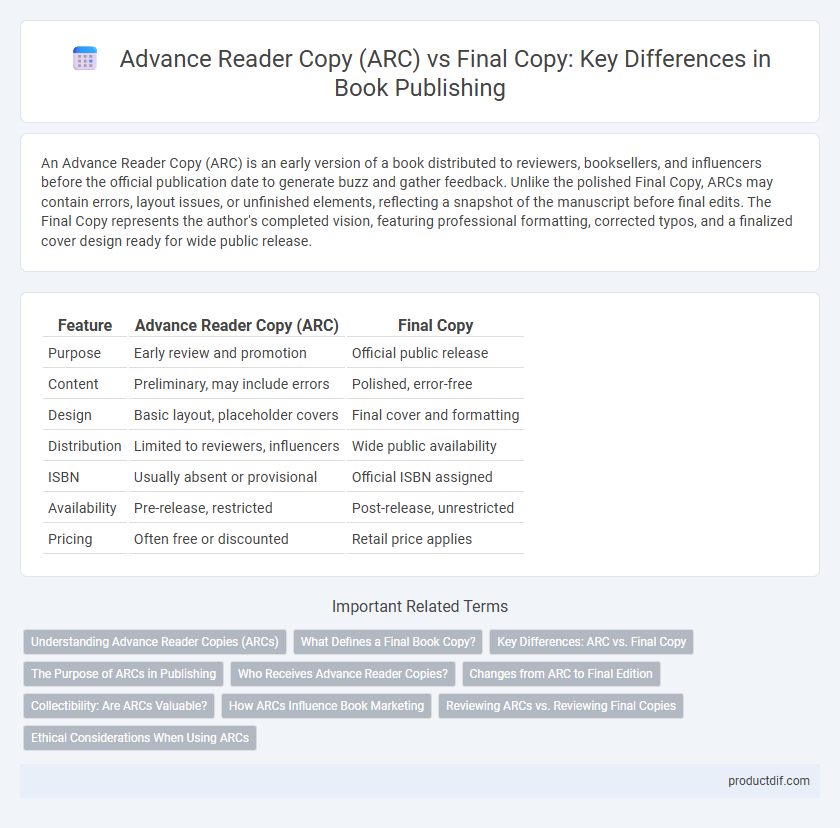An Advance Reader Copy (ARC) is an early version of a book distributed to reviewers, booksellers, and influencers before the official publication date to generate buzz and gather feedback. Unlike the polished Final Copy, ARCs may contain errors, layout issues, or unfinished elements, reflecting a snapshot of the manuscript before final edits. The Final Copy represents the author's completed vision, featuring professional formatting, corrected typos, and a finalized cover design ready for wide public release.
Table of Comparison
| Feature | Advance Reader Copy (ARC) | Final Copy |
|---|---|---|
| Purpose | Early review and promotion | Official public release |
| Content | Preliminary, may include errors | Polished, error-free |
| Design | Basic layout, placeholder covers | Final cover and formatting |
| Distribution | Limited to reviewers, influencers | Wide public availability |
| ISBN | Usually absent or provisional | Official ISBN assigned |
| Availability | Pre-release, restricted | Post-release, unrestricted |
| Pricing | Often free or discounted | Retail price applies |
Understanding Advance Reader Copies (ARCs)
Advance Reader Copies (ARCs) are pre-publication versions of books distributed to reviewers, booksellers, and influencers to generate early buzz and gather feedback. These copies often contain minor errors and lack the polished formatting found in final copies, making them distinct in quality and presentation. Understanding ARCs helps readers and industry professionals anticipate the book's content while recognizing that changes may occur before the official release.
What Defines a Final Book Copy?
A final book copy is the definitive version designated for mass production and public distribution, incorporating all approved edits, formatting adjustments, and design elements. Unlike an Advance Reader Copy (ARC), which may contain typographical errors or incomplete elements, the final copy undergoes rigorous proofreading, typesetting, and quality control to ensure accuracy and visual consistency. This finalized edition represents the author and publisher's intended presentation of the complete work.
Key Differences: ARC vs. Final Copy
Advance Reader Copy (ARC) is an early version of a book distributed to reviewers, booksellers, and influencers to generate buzz before the official release. ARCs often contain uncorrected errors, missing final edits, and preliminary cover designs, distinguishing them from the polished Final Copy. The Final Copy includes all corrections, finalized formatting, and final artwork, ensuring optimal reader experience and market readiness.
The Purpose of ARCs in Publishing
Advance Reader Copies (ARCs) serve as pre-publication editions designed to generate early buzz and solicit reviews from influencers and critics before the official release. These copies help publishers identify potential issues and gauge audience reactions, enabling refinements in marketing strategies and final edits. ARCs are instrumental in building anticipation and ensuring a successful book launch by creating momentum within the literary community.
Who Receives Advance Reader Copies?
Advance Reader Copies (ARCs) are typically distributed to book reviewers, bloggers, librarians, booksellers, and literary agents well before the official publication date to generate early buzz and gather feedback. Authors and publishers send ARCs to industry professionals and influential readers who can provide reviews, endorsements, and social media promotion. Final copies are reserved for general sale to the public and contain finalized text and design, ensuring readers receive the polished, published edition.
Changes from ARC to Final Edition
Advance Reader Copies (ARCs) often contain content that is subject to change, including edits to plot details, character development, and dialogue, which are refined in the final edition to improve narrative coherence and reader engagement. Errors such as typos, formatting inconsistencies, and factual inaccuracies found in ARCs are corrected before the final print run. Publishers use feedback from ARC readers to implement structural changes, ensuring the final edition delivers a polished and compelling reading experience.
Collectibility: Are ARCs Valuable?
Advance Reader Copies (ARCs) hold significant collectibility value due to their limited print runs and unique content variations compared to final copies. Collectors often seek ARCs for exclusive cover art, typographical errors, and pre-release insights, making them rare and desirable items in the book market. The scarcity and distinctiveness of ARCs contribute to their higher demand and potential appreciation among bibliophiles and book investors.
How ARCs Influence Book Marketing
Advance Reader Copies (ARCs) generate early buzz by providing bloggers, reviewers, and industry professionals with exclusive access to a book before its official release. These pre-publication copies help create authentic reviews and word-of-mouth promotion, driving anticipation and early pre-orders. ARCs play a crucial role in book marketing by building momentum and increasing visibility in competitive literary markets.
Reviewing ARCs vs. Reviewing Final Copies
Reviewing Advance Reader Copies (ARCs) allows readers and critics to provide feedback on plot development, character arcs, and potential errors before the book's final edits, often influencing last-minute revisions. Final copies, on the other hand, represent the polished and authoritative version of the text, offering a definitive reading experience without the preliminary inconsistencies or unfinished elements found in ARCs. Engaging with ARCs focuses on constructive critique to improve the work, while reviewing final copies emphasizes evaluation of the completed literary product for publication quality and reader reception.
Ethical Considerations When Using ARCs
Advance Reader Copies (ARCs) present ethical considerations including respecting copyright and embargo agreements to prevent unauthorized distribution before the official release date. Readers and reviewers must avoid sharing ARC content publicly or leaking plot details, ensuring that authors' intellectual property rights and marketing strategies are upheld. Maintaining confidentiality supports trust between publishers, authors, and readers while fostering a responsible literary community.
Advance Reader Copy (ARC) vs Final Copy Infographic

 productdif.com
productdif.com